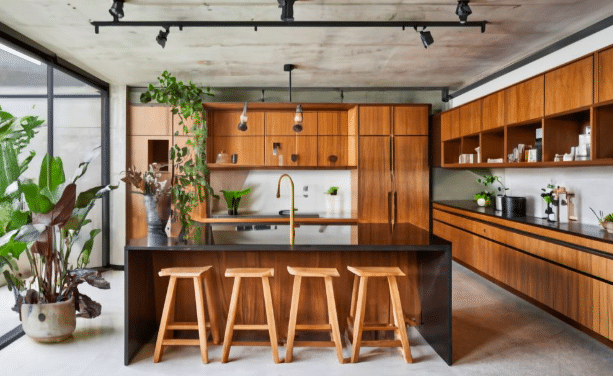Sustainable and Eco-Friendly Kitchen Design: Cultivating a Green Kitchen Haven
In today’s environmentally conscious world, many of us are striving to reduce our ecological footprint and embrace sustainable practices in every aspect of our lives. The kitchen, often considered the heart of the home, presents a unique opportunity to integrate eco-friendly design principles without compromising on functionality or aesthetics. By making informed choices regarding appliances, materials, and daily habits, you can create a sustainable and eco-friendly kitchen design that reflects your commitment to a green lifestyle.
Embracing Sustainability in Your Kitchen Design
The foundation of a sustainable kitchen lies in incorporating energy-efficient appliances, water-saving fixtures, and LED lighting:
- Energy-efficient appliances: Look for appliances with the Energy Star® label, indicating they meet strict criteria for energy efficiency. These appliances use significantly less energy than traditional models, reducing your environmental impact and lowering your energy bills by up to 30%, according to the Environmental Protection Agency (EPA).
- Water-saving faucets and fixtures: Installing low-flow faucets and showerheads can significantly reduce water consumption in your kitchen. The EPA estimates that a low-flow faucet can save an average family up to 700 gallons of water per year, contributing to the conservation of this precious resource.
- LED lighting: Replace traditional incandescent bulbs with LED lights. LEDs are not only energy-efficient, using up to 75% less energy than traditional bulbs, but they also last 25 times longer, reducing waste and saving money on replacements. Additionally, LEDs emit minimal heat, contributing to a cooler and more comfortable kitchen environment.
Building a Green Kitchen with Sustainable Materials
Beyond energy-efficient appliances and lighting, the materials you choose for your kitchen play a crucial role in sustainability:
- Mindful material selection: Opt for eco-friendly and sustainable materials for cabinets, countertops, and flooring. Consider recycled wood, which utilizes reclaimed wood from various sources, or bamboo, a fast-growing and renewable resource. Cork flooring is another sustainable option, offering a unique aesthetic while being naturally water-resistant and insulating. Additionally, consider sustainably sourced stone countertops, ensuring responsible quarrying practices and minimal environmental impact.
- Responsible waste management: Integrate composting and recycling into your kitchen design by incorporating designated bins and ensuring proper waste disposal practices. Composting food scraps and yard waste reduces landfill waste and creates nutrient-rich compost for your garden. Additionally, recycling paper, plastic, and metal reduces the need for virgin materials and conserves resources.
Additional Eco-Friendly Kitchen Practices
While choosing the right appliances and materials is vital, everyday habits can significantly impact your kitchen’s sustainability:
- Embrace natural light: Maximize the use of natural light in your kitchen by strategically placing windows and skylights. This reduces your reliance on artificial lighting during the day, saving energy and creating a brighter and more inviting kitchen space.
- Minimize water waste: Simple practices like using a bowl of water for rinsing vegetables instead of running water constantly can significantly reduce water consumption.
- Choose reusable products: Opt for reusable water bottles, cloth napkins, and shopping bags instead of disposable alternatives. These choices not only reduce waste generation but also save money in the long run.
Going Beyond the Basics
While the tips above provide a strong foundation, consider these additional steps to further enhance your sustainable kitchen design:
- Energy-efficient dishwashers: Look for dishwashers with features like air drying, which eliminates the need for the energy-intensive heat drying cycle.
- Smart appliances: Consider smart appliances that allow you to monitor and control energy usage remotely, helping you optimize efficiency.
- Water-efficient dishwashers: Opt for dishwashers with a WaterSense® label, indicating they meet strict criteria for water efficiency, using significantly less water per cycle compared to traditional models.
- Local and organic food: Supporting local farmers and purchasing organic food reduces the environmental impact associated with transportation and conventional farming practices.
Conclusion
By embracing sustainable and eco-friendly kitchen design principles, you can create a beautiful and functional space that reflects your commitment to a green lifestyle. Remember, every choice, from the appliances you use to the materials you select, has an impact. To cultivate a green kitchen haven that embodies sustainability and eco-friendliness, make the conscious choice to collaborate with MRD. Transform your kitchen into a space that harmonizes functionality with environmental consciousness by reaching out to MRD today. Let their expertise in sustainable design principles bring your vision to life, creating a kitchen that not only looks stunning but also contributes to a greener future. Take the first step towards a sustainable culinary sanctuary – contact MRD now and embark on a journey to a more environmentally friendly kitchen!



